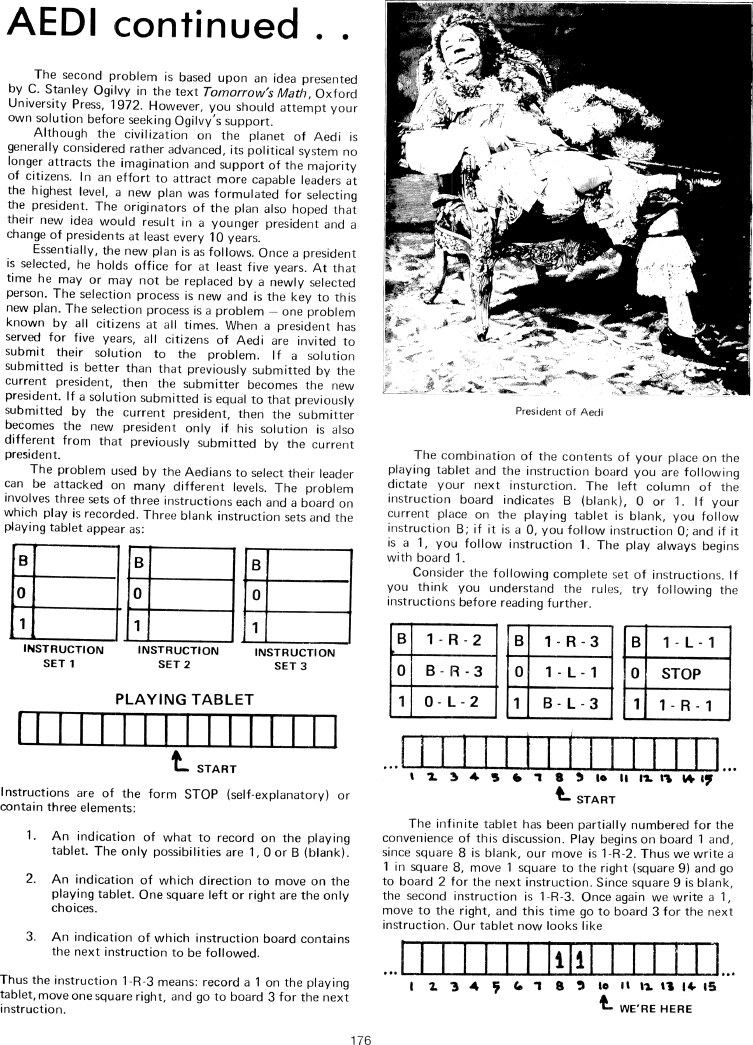The Best of Creative Computing Volume 1 (published 1976)
AEDI, MUTAB, NEDA, and SOGAL

AEDI continued . .
The second problem is based upon an idea presented by C. Stanley Ogilvy in the
text Tomorrow’s Math, Oxford University Press, 1972. However, you should
attempt your own solution before seeking Ogilvy's support.
Although the civilization on the planet of Aedi is generally considered rather
advanced, its political system no longer attracts the imagination and support of
the majority of citizens. In an effort to attract more capable leaders at the
highest level, a new plan was formulated for selecting the president. The
originators of the plan also hoped that their new idea would result in a younger
president and a change of presidents at least every 10 years.
Essentially, the new plan is as follows. Once a president is selected, he holds
office for at least five years. At that time he may or may not be replaced by a
newly selected person. The selection process is new and is the key to this new
plan. The selection process is a problem-one problem known by all citizens at
all times. When a president has served for five years, all citizens of Aedi are
invited to submit their solution to the problem. lf a solution submitted is
better than that previously submitted by the current president, then the
submitter becomes the new president. lf a solution submitted is equal to that
previously submitted by the current president, then the submitter becomes the
new president only if his solution is also different from that previously
submitted by the current president.
The problem used by the Aedians to select their leader can be attacked on many
different levels. The problem involves three sets of three instructions each and
a board on which play is recorded. Three blank instruction sets and the playing
tablet appear as:
INSTRUCTION INSTRUCTION INSTRUCTION
SET 1 SET 2 SET 3
PLAYING TABLET
START
Instructions are of the form STOP (self-explanatory) or contain three elements:
1. An indication of what to record on the playing tablet. The only possibilities
are 1,0 or B (blank).
2. An indication of which direction to move on the playing tablet. One square
left or right are the only choices.
3. An indication of which instruction board contains the next instruction to be
followed.
Thus the instruction 1-R-3 means: record a 1 on the playing tablet, move one
square right, and go to board 3 for the next instruction.
[image]
President of Aedi
The combination of the contents of your place on the playing tablet and the
instruction board you are following dictate your next instruction, The left
column of the instruction board indicates B (blank), 0 or 1. lf your current
place on the playing tablet is blank, you follow instruction B; if it is a 0,
you follow instruction 0; and if it is a 1, you follow instruction 1. The play
always begins with board 1.
Consider the following complete set of instructions. lf you think you understand
the rules, try following the instructions before reading further.
[image]
START
The infinite tablet has been partially numbered for the convenience of this
discussion. Play begins on board 1 and, since square 8 is blank, our move is
1-R-2. Thus we write a 1 in square 8, move 1 square to the right (square 9) and
go to board 2 for the next instruction. Since square 9 is blank, the second
instruction is 1-R-3. Once again we write a 1, move to the right, and this time
go to board 3 for the next instruction. Our tablet now looks like
[image]
tWE'RE HERE
176


